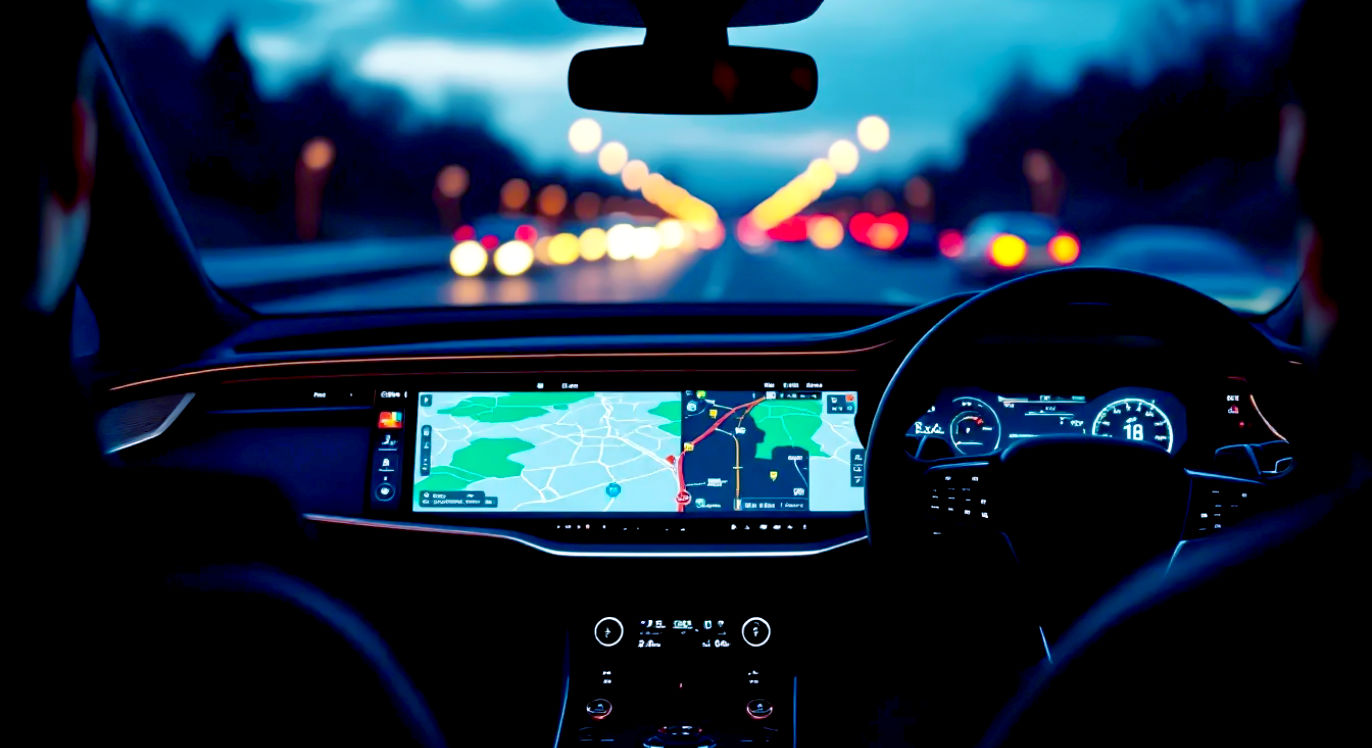The Guide to In-Car Tech: From Dash Cams to Digital Radio
Confused by car tech? Our ultimate guide breaks down everything a British driver needs to know about dash cams, infotainment, parking sensors, and more.

This post may contain affiliate links. If you make a purchase through these links, we may earn a commission at no additional cost to you.
Driving isn’t just about getting from A to B anymore, is it? For decades, the car was a simple machine: engine, wheels, and a crackly radio for company. But today, stepping into a modern car can feel like sitting in a spaceship. Screens glow, voices give directions, and music streams from your phone without a single wire. It’s brilliant, but it can also be a bit bewildering.
If you’ve ever felt a bit lost trying to figure out what a dash cam actually does, why your phone won’t connect to Bluetooth, or what on earth DAB radio is, you’re in the right place. This isn’t a stuffy manual full of jargon. Think of it as a friendly chat with a mate who knows his way around car gadgets. We’re going to break down everything you need to know about the electronic gizmos that make our drives safer, easier, and a lot more fun. We’ll look at where this tech came from, how it works, and what you really need in your car today. So, buckle up, and let’s get started on our road trip through the world of in-car electronics.
What Are In-Car Electronics Anyway? A Simple Breakdown
At its heart, in-car consumer electronics—sometimes called automotive electronics—is just a fancy term for any gadget in your car that runs on electricity and is designed to be used by you, the driver or passenger. It’s not the complicated stuff that makes the engine run or the brakes work. Instead, it’s all the tech that informs, entertains, and helps you on your journey.
Think about it. The first car radio, a massive thing bolted under the seat in the 1930s, was a piece of consumer electronics. So was the first car cassette player that let people blast out Queen on the motorway in the 70s. And the Sat Nav that stopped countless arguments about map reading in the early 2000s? That too.
Today, this tech is split into a few main areas:
- Infotainment: This is the big one. It’s a blend of ‘information’ and ‘entertainment’. It’s your car’s central screen, the system that handles music, radio, navigation, and phone calls.
- Driver Aids: These are the clever bits of tech designed to make driving safer and easier. Think parking sensors that beep when you get too close to a wall, or cruise control that keeps your speed steady on a long drive.
- Safety and Security: This category includes gadgets that protect you and your car. Dash cams are the most famous example, recording your journey in case of an accident. Car alarms and trackers also fit in here.
- Connectivity: This is all about how your car talks to your other devices and the world around it. Bluetooth for hands-free calls, USB ports for charging your phone, and even in-car Wi-Fi fall into this group.
It might sound like a lot, but don’t worry. Most of these systems are designed to be simple to use. The real challenge is knowing what’s worth having and what’s just a flashy gimmick.
The Journey of In-Car Tech: From Crackly Radios to Connected Cars
To really get a grip on the tech in our cars today, it helps to know where it all came from. The story of in-car electronics is a fascinating journey that mirrors the incredible pace of technology over the last century.
The Dawn of In-Car Entertainment: The Wireless
Back in the 1920s and 30s, the car was a noisy, mechanical beast. The idea of listening to music while you drove was pure science fiction. But then came the radio. The first commercially successful car radio, the Motorola 5T71, appeared in 1930. It was a huge, expensive luxury, costing about a third of the price of the car itself! In Britain, early car radios were a symbol of wealth and modernity. You’d see them in posh Rovers and Bentleys cruising through London.
For decades, the AM radio was the only entertainment you had. You’d tune into the BBC Light Programme, listening to shows and music, with the signal fading in and out as you drove through the countryside. It wasn’t perfect, but it was revolutionary. It turned the car from a simple transport tool into a personal space, a bubble where you could enjoy your own world.
The 60s and 70s: Tapes, Tracks, and Freedom
The post-war boom brought more cars to British roads than ever before. People were driving further for holidays and work. And they wanted their own music. The 1960s delivered with the 8-track tape. It was a chunky plastic cartridge that let you play a pre-recorded album. It was clunky and the tracks would often change halfway through a song, but it was a taste of freedom. You could listen to The Beatles or The Rolling Stones on repeat, not just when the radio decided to play them.
The cassette tape arrived shortly after and was a massive improvement. It was smaller, you could record your own mixtapes from the radio (a rite of passage for any teenager), and the players were more reliable. The 1980s was the golden age of the cassette, with fancy stereos featuring graphic equalizers and auto-reverse. Driving down the M1 with a C90 cassette blasting out The Human League or Duran Duran was the height of cool.
The Digital Revolution: CDs, Sat Navs, and the First Screens
The 1990s brought the Compact Disc (CD). The sound quality was crystal clear, a huge leap from the hiss of a cassette. Cars started coming with CD players, and for a while, we all had wallets of CDs sliding around in the glovebox.
But the biggest change was just around the corner. In the late 90s and early 2000s, something amazing happened: Satellite Navigation, or Sat Nav. Early systems were basic, often using a CD-ROM with map data that would quickly go out of date. But dedicated devices from companies like TomTom and Garmin changed everything.
Suddenly, you didn’t need an A-Z map book to navigate a new city. A calm voice (often nicknamed ‘Stephen’ or ‘Jane’) would give you turn-by-turn directions. It saved marriages, prevented countless wrong turns, and made exploring the UK’s winding B-roads a joy rather than a terror. For a nation of keen drivers and explorers, the Sat Nav was a game-changer. It’s no exaggeration to say it opened up the country for many people.
The Modern Era: Connectivity and the Smartphone Takeover
The last 15 years have seen the most dramatic changes of all, and it’s all down to one device: the smartphone.
Bluetooth was the first step. This wireless technology let you connect your phone to your car for hands-free calls. It became a legal requirement to use a hands-free device while driving in the UK in 2003, and Bluetooth made that easy. No more dodgy earpieces.
Then came proper smartphone integration. Apple CarPlay and Android Auto arrived around 2014. These systems don’t just connect your phone; they mirror a simplified version of your phone’s screen onto the car’s infotainment display. Suddenly, you could use your favourite apps—Spotify for music, Waze for navigation, WhatsApp for messages (read aloud, of course)—safely and easily. This was a monumental shift. The car’s built-in system was no longer the star; it was just a screen for the powerful computer we all carry in our pockets.
This brings us to today, where the modern car is a fully connected hub. It’s a story of how a simple desire for a bit of music on the road evolved into a complex ecosystem of safety, navigation, and entertainment, all seamlessly integrated.
The Heart of the Modern Car: The Infotainment System
Walk into any new car showroom today, and the first thing you’ll notice is the screen. It’s usually big, bright, and sitting right in the middle of the dashboard. This is the infotainment system, and it’s the brain of your car’s consumer electronics.
Let’s break down what it does and the key features you need to know about.
What Is It, Really?
Think of the infotainment system as a tablet computer that’s built into your car. It has a processor, memory, and a touch screen, just like an iPad. Its job is to control all the non-driving functions of the car in one central place.
A typical system will handle:
- Audio: Radio (AM/FM/DAB), music from your phone, podcasts.
- Navigation: Built-in maps and directions.
- Phone: Making and receiving calls, accessing contacts.
- Settings: Customising things like the car’s lighting, locking, and display preferences.
The Screen: Size and Type
The screen is your window into the system. They range in size from about 7 inches (like a small tablet) to massive 17-inch vertical screens like those in a Tesla.
- Resistive vs. Capacitive: This sounds technical, but it’s simple. Resistive screens are the older type. You have to press them firmly, and they can feel a bit slow. Capacitive screens are what you have on your smartphone. They’re bright, responsive, and support multi-touch gestures like pinching to zoom on a map. Almost all new cars use capacitive screens now, and you should insist on one if buying used.
- Resolution: Just like a TV, a higher resolution means a sharper, clearer picture. This is especially important for navigation, where you want maps to be crisp and easy to read at a glance.
The Key Features Explained
DAB Radio: The Modern Standard
You might have noticed that FM radio is starting to sound a bit old-fashioned. DAB (Digital Audio Broadcasting) is the new standard in the UK.
- Simplified Explanation: DAB is like the digital TV (Freeview) version of radio. It finds all the available stations for you and lists them by name. No more trying to remember frequencies like “98.8 FM”.
- Detailed Explanation: DAB transmits digital data instead of an analogue wave. This means it’s less prone to interference, so you don’t get that annoying hiss and crackle when the signal is weak. It either works perfectly, or it doesn’t work at all. It also allows for many more stations to be broadcast. That’s why you get dozens of extra channels like BBC Radio 6 Music, Absolute 80s, and Kisstory that you can’t find on FM. Most new cars in the UK come with DAB as standard. It’s a must-have.
Bluetooth: The Essential Connection
We mentioned it before, but it’s worth repeating: Bluetooth is a non-negotiable feature. It’s a wireless technology that lets devices talk to each other over short distances.
In your car, it does two key things:
- Hands-Free Calling: It connects to your phone so you can make and receive calls using the car’s speakers and a built-in microphone. You can usually browse your contacts and call history on the car’s screen.
- Audio Streaming: You can play any audio from your phone—Spotify, Apple Music, BBC Sounds, YouTube—wirelessly through the car’s stereo.
Setting it up is usually a one-time job. You ‘pair’ your phone with the car, and after that, it should connect automatically every time you get in.
Apple CarPlay and Android Auto: The Game-Changers
This is arguably the most important feature in any modern infotainment system. Apple CarPlay (for iPhones) and Android Auto (for Android phones) are clever systems that put a car-friendly version of your phone’s interface on the infotainment screen.
- How it Works: You plug your phone into the car’s USB port (or connect wirelessly in some newer cars). The infotainment screen then changes to show a simple layout with large icons for your compatible apps. You can control them using the touchscreen, buttons on the steering wheel, or voice commands (Siri for Apple, Google Assistant for Android).
- Why it’s Brilliant:
- Familiarity: You’re using the apps you already know and love.
- Up-to-Date Navigation: You can use Google Maps, Waze, or Apple Maps, which are constantly updated for free. This is often far better than a car’s built-in Sat Nav, which can have outdated maps that are expensive to update.
- Music and Podcasts: All your playlists and podcast subscriptions from Spotify, Apple Music, or BBC Sounds are right there.
- Messaging: It can read incoming messages from WhatsApp or iMessage aloud, and you can dictate a reply without ever touching your phone.
If you’re buying a new or nearly new car, do not buy one without Apple CarPlay or Android Auto. It is the single best feature for making your in-car tech experience seamless and safe.
Staying Safe: Dash Cams, Parking Sensors, and Other Helpers
Beyond entertainment, consumer electronics play a huge role in making our journeys safer. These gadgets act as an extra pair of eyes and ears, helping to prevent accidents and protecting you when things go wrong.
Dash Cams: Your Independent Witness
The Dashboard Camera, or dash cam, has become incredibly popular in the UK over the last decade. And for good reason. It’s a small camera that mounts to your windscreen and continuously records the road ahead.
- Simplified Explanation: It’s like having a CCTV camera for your car. It records everything that happens on your journey. If you have an accident, you have video proof of exactly what happened.
- Detailed Explanation: A dash cam records video onto a small memory card (a MicroSD card). It records in a ‘loop’, meaning when the card is full, it automatically starts recording over the oldest files. So, you don’t need to worry about it running out of space.
- G-Sensor: Crucially, all modern dash cams have a G-sensor. This sensor detects sudden impacts, like in a crash. When it does, it automatically locks the current video file and saves it in a separate folder so it can’t be overwritten. This is your evidence.
- Why You Need One: In the UK, dash cam footage is accepted by the police and insurance companies as evidence. It can be vital for proving you weren’t at fault in an accident, protecting your no-claims bonus and preventing fraudulent ‘crash for cash’ scams. Some insurers even offer a discount if you have one fitted.
- Key Features to Look For:
- Resolution: Look for at least 1080p (Full HD). Higher resolutions (like 1440p or 4K) make it easier to read number plates.
- Night Vision: Essential for driving at night. A good sensor (often from Sony, called a STARVIS sensor) makes a huge difference.
- Parking Mode: This allows the camera to automatically start recording if it detects a bump while your car is parked. It requires the dash cam to be professionally ‘hardwired’ into the car’s electrics.
- Front and Rear: Some kits come with a second, smaller camera to record what’s happening behind you. This is great for capturing rear-end shunts.
A good dash cam from a brand like Nextbase or Garmin is a small investment that can save you a huge amount of money and stress.
Parking Aids: Saying Goodbye to Bumps and Scrapes
Parking can be the most stressful part of any journey, especially in tight British multi-storey car parks or on narrow residential streets. Modern electronics provide the perfect solution.
Parking Sensors
- How They Work: These are small, circular sensors embedded in your car’s bumpers (front and/or rear). They use ultrasonic waves (like a bat’s sonar) to detect objects. As you get closer to an object, a speaker inside the car emits a series of beeps that get faster and faster, turning into a solid tone when you’re about to hit something.
- Are They Worth It? Absolutely. They are brilliant for judging distances to low walls or bollards that you can’t see from the driver’s seat. They can be fitted to almost any car as an aftermarket accessory if it doesn’t have them as standard.
Reversing Cameras
A step up from sensors is the reversing camera. When you put the car in reverse, the infotainment screen automatically shows a live video feed of what’s behind you.
- Key Feature: Guidelines: Most systems overlay coloured guidelines on the video feed. These show the path your car will take as you reverse. Some even have ‘dynamic’ guidelines that bend as you turn the steering wheel, showing you exactly where you’re headed. It makes parallel parking a doddle.
360-Degree Cameras (or ‘Bird’s-Eye View’)
This is the ultimate parking aid, usually found on more expensive cars. It uses several small cameras hidden around the car (in the grille, under the wing mirrors, and at the back). Clever software stitches these video feeds together to create a virtual top-down, ‘bird’s-eye view’ of your car and its immediate surroundings. It’s like you’re floating above the car, watching yourself park. It completely eliminates blind spots and makes manoeuvring in tight spaces incredibly easy.
Convenience and Comfort: Making Driving a Breeze
The best technology is the kind that fades into the background, quietly making your life easier. This next group of gadgets does just that.
Cruise Control and its Clever Cousin, Adaptive Cruise Control
Cruise control is a system that automatically controls the speed of your car. You get up to your desired speed on a motorway or A-road, press a button, and the car will maintain that speed without you needing to keep your foot on the accelerator. It’s fantastic for reducing fatigue on long journeys.
Adaptive Cruise Control (ACC) is the next level up.
- Simplified Explanation: It’s cruise control that can see. It uses a radar or camera at the front of the car to monitor the vehicle ahead.
- Detailed Explanation: With ACC, you set your desired speed and a desired following distance (usually with options like close, medium, or far). The car will then maintain your set speed, but if the car in front slows down, your car will automatically slow down too, maintaining the safe gap you’ve chosen. When the car in front speeds up or moves out of the way, your car will automatically accelerate back to your set speed.
- Stop & Go: The most advanced ACC systems can even work in traffic jams. They can bring the car to a complete stop and then start it moving again when the traffic moves, all without you touching the pedals. This tech is transforming the stop-start drudgery of the daily commute on roads like the M25.
Keyless Entry and Start
This is a simple but wonderful piece of tech. With keyless entry, you can leave the car key in your pocket or bag. The car has sensors that detect when the key is nearby. To unlock the car, you just touch the door handle or press a small button on it. To start the car, you just put your foot on the brake (or clutch in a manual) and press a ‘Start/Stop’ button on the dashboard. No more fumbling for keys in the rain.
- A Note on Security: Early keyless entry systems were vulnerable to ‘relay theft’, where thieves use a device to capture the key’s signal from inside your house. Modern systems have improved security, and you can protect your key by keeping it in a special signal-blocking pouch (a Faraday pouch) at home.
USB Ports and Wireless Charging
Our devices need power, and cars have become mobile charging stations.
- USB Ports: Almost every new car has at least one USB port. But not all USB ports are equal.
- USB-A: The traditional, rectangular-shaped port.
- USB-C: The newer, smaller, oval-shaped port. It can deliver more power for faster charging.
- Power vs. Data: Some USB ports are for charging only, while others can also handle data (this is the one you need to use for Apple CarPlay or Android Auto). They are often marked with a small battery symbol or a phone/data symbol.
- Wireless Charging: Many new cars have a dedicated wireless charging pad (often based on the ‘Qi’ standard). If you have a compatible smartphone, you can just place it on the pad, and it will start charging automatically. No cables, no fuss. It’s a brilliant, clutter-free solution.
The Future is Now: What’s Next for In-Car Tech?
The world of car electronics is moving at lightning speed. The tech that seems futuristic today will be standard in just a few years. Here’s a peek at what’s on the horizon.
The Rise of the ‘Digital Cockpit’
For a century, the driver’s view has been dominated by physical, analogue dials for speed and engine revs. That’s changing. The digital cockpit (or ‘virtual cockpit’) replaces those traditional dials with a high-resolution screen.
- What it Offers: This screen is highly customisable. You can choose to have a traditional-looking set of dials, or you can shrink them down and have a huge, full-screen navigation map right in your line of sight. It can also display music information, phone contacts, or driver-assist information. It puts the most important information directly in front of the driver, which is safer than constantly glancing over at the central infotainment screen.
Connected Car Services
Cars are becoming permanently connected to the internet via their own built-in SIM card. This opens up a world of possibilities, known as connected car services.
- Live Traffic and Re-routing: Your built-in Sat Nav can get real-time traffic information from the internet, helping you avoid jams just like Google Maps or Waze.
- Remote Services: Using a smartphone app, you can connect to your car from anywhere. You could check if it’s locked, see how much fuel is left, or even pre-heat the cabin on a cold winter morning.
- Emergency Call (eCall): This is now a legal requirement for all new cars sold in the UK and Europe. If you have a serious accident and the airbags deploy, the car automatically calls the emergency services and transmits your exact GPS location. It’s a feature you hope you’ll never need, but it could be a lifesaver.
The Road to Self-Driving
We’re not quite at the stage of having a nap while your car drives you to work, but the building blocks are already here. Features like Adaptive Cruise Control and Lane Keeping Assist (which uses a camera to read the white lines and gently steers to keep you in your lane) are the first steps towards autonomous driving. This technology will continue to get smarter, taking more of the strain out of long, boring, or stressful driving situations.
Your Checklist: What to Look for When Buying a Car
So, you’re looking for a new or used car and want to make sure you get the right tech. Here’s a simple checklist of the essentials and the ‘nice-to-haves’.
The Must-Haves (Don’t leave the showroom without these):
- DAB Radio: Essential for future-proofed radio listening in the UK.
- Bluetooth: For safe, legal, hands-free calls and easy audio streaming.
- Apple CarPlay / Android Auto: The best and safest way to use your phone’s key features in the car. Massively preferable to most manufacturers’ built-in software.
- Parking Sensors (at least rear): Will save you from countless small dings and scrapes.
- USB Ports: At least one for charging and connecting your phone.
The Highly Recommended (Features that make a big difference):
- Reversing Camera: Makes parking so much easier and safer.
- Built-in Sat Nav (as a backup): Useful for when you don’t have a phone signal, but make sure it has free map updates if possible.
- Adaptive Cruise Control: If you do a lot of motorway driving, this is a game-changing feature for reducing stress and fatigue.
- Keyless Entry/Start: A small convenience that you’ll quickly come to love.
The Luxury Extras (Great if you can get them):
- 360-Degree Camera: The ultimate parking gadget.
- Wireless Charging Pad: For a tidy, cable-free cabin.
- Digital Cockpit: Looks cool and puts key information right where you need it.
- Premium Sound System: If you’re a music lover, a branded system (like Bose, Harman Kardon, or Bowers & Wilkins) can offer a stunning audio experience.
Final Thoughts: Embracing the Tech
The electronics in our cars have come a long way from a single crackly radio speaker. They have transformed driving, making it safer, less stressful, and more enjoyable than ever before. It can seem like a lot to take in, but remember, this technology is designed to help you, not to confuse you.
Don’t be afraid to spend some time sitting in a car (either your own or one at a dealership) and just playing with the infotainment system. Connect your phone, try out the voice commands, and adjust the settings. The more familiar you are with it, the more you’ll get out of it.
The key is to focus on the features that will genuinely make your daily driving life better. For most people in Britain today, that means a seamless phone connection through CarPlay or Android Auto, the clear sound of DAB radio, and the peace of mind that comes from a dash cam and parking sensors. Get those right, and you’ll have a car that’s not just a tool for getting around, but a true companion for the road ahead.
Further Reading & Resources
- What Car?: An excellent UK-based resource for car reviews, including detailed breakdowns of infotainment systems and technology packs. https://www.whatcar.com/
- Auto Express: Another leading British car magazine with in-depth tech reviews and group tests of products like dash cams. https://www.autoexpress.co.uk/
- Nextbase: The UK’s leading dash cam manufacturer, their website has a lot of useful information and guides on how the technology works. https://www.nextbase.com/en-gb/






